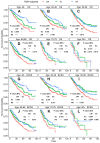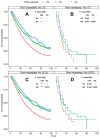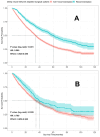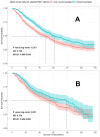Deep neural network provides personalized treatment recommendations for de novo metastatic breast cancer patients
- PMID: 39668839
- PMCID: PMC11632994
- DOI: 10.7150/jca.101293
Deep neural network provides personalized treatment recommendations for de novo metastatic breast cancer patients
Abstract
Background: It has long been controversial whether surgery should be performed for de novo metastatic breast cancer (dnMBC). The choice and timing of the primary tumor resection for dnMBC patients need to be individualized, but there was no tool to assist clinicians in decision-making. Methods: A 1:1:2 propensity score matching (PSM) was applied to examine the prognosis of dnMBC patients who underwent neoadjuvant systemic therapy followed by surgery (NS), surgery followed by chemotherapy (SC), and chemotherapy without surgery (CW). Then, two deep feed-forward neural network models were constructed to conduct personalized treatment recommendations. Results: The PSM-adjusted data showed that not all the dnMBC patients could benefit from surgery, and the advantages of NS and SC were different among various subgroups. Patients with stage T1-2, and pathological grade II tumors can be operated on directly, whereas those with stage T3-4, pathological grade III/IV diseases require NS. However, patients with grade I diseases, over 80 years of age, or with brain metastases could not benefit from surgery, regardless of whether they received neoadjuvant systemic therapy. Our deep neural network models exhibited high accuracy on both the train and test sets, one model can assist in deciding whether surgery is requested for dnMBC patient, if the surgery is necessary, another model can determine whether neoadjuvant systemic therapy is needed. Conclusion: This study investigated the prognosis of dnMBC patients, and two artificial intelligence (AI) assisted surgery decision-making models were developed to assist clinicians in delivering precision medicine while improving the survival of dnMBC patients.
Keywords: deep neural network; dnMBC; neoadjuvant systemic therapy; surgery.
© The author(s).
Conflict of interest statement
Competing Interests: The authors have declared that no competing interest exists.
Figures









Similar articles
-
Aggressive local therapy for de novo metastatic breast cancer: Challenges and updates (Review).Oncol Rep. 2023 Sep;50(3):163. doi: 10.3892/or.2023.8600. Epub 2023 Jul 14. Oncol Rep. 2023. PMID: 37449542 Free PMC article. Clinical Trial.
-
Axillary lymph node removal in de novo metastatic breast cancer.Gland Surg. 2024 Jul 30;13(7):1214-1228. doi: 10.21037/gs-24-130. Epub 2024 Jul 24. Gland Surg. 2024. PMID: 39175710 Free PMC article.
-
Does definitive local therapy have a role in select HER2+ de novo metastatic breast cancer patients treated with dual anti-HER2 blockade?Breast Cancer Res Treat. 2022 Jan;191(2):375-383. doi: 10.1007/s10549-021-06440-z. Epub 2021 Nov 17. Breast Cancer Res Treat. 2022. PMID: 34787760
-
The Role of Primary Surgery in De Novo Metastatic Breast Carcinoma.Eur J Breast Health. 2023 Apr 1;19(2):110-114. doi: 10.4274/ejbh.galenos.2023.2023-3-7. eCollection 2023 Apr. Eur J Breast Health. 2023. PMID: 37025581 Free PMC article. Review.
-
Overview of resistance to systemic therapy in patients with breast cancer.Adv Exp Med Biol. 2007;608:1-22. doi: 10.1007/978-0-387-74039-3_1. Adv Exp Med Biol. 2007. PMID: 17993229 Review.
Cited by
-
Options for postoperative radiation therapy in patients with de novo metastatic breast cancer.Breast. 2025 Aug;82:104483. doi: 10.1016/j.breast.2025.104483. Epub 2025 Apr 23. Breast. 2025. PMID: 40286762 Free PMC article.
-
Development and validation of novel machine learning-based prognostic models and propensity score matching for comparison of surgical approaches in mucinous breast cancer.Front Endocrinol (Lausanne). 2025 Jun 3;16:1557858. doi: 10.3389/fendo.2025.1557858. eCollection 2025. Front Endocrinol (Lausanne). 2025. PMID: 40529827 Free PMC article.
References
LinkOut - more resources
Full Text Sources
Miscellaneous

